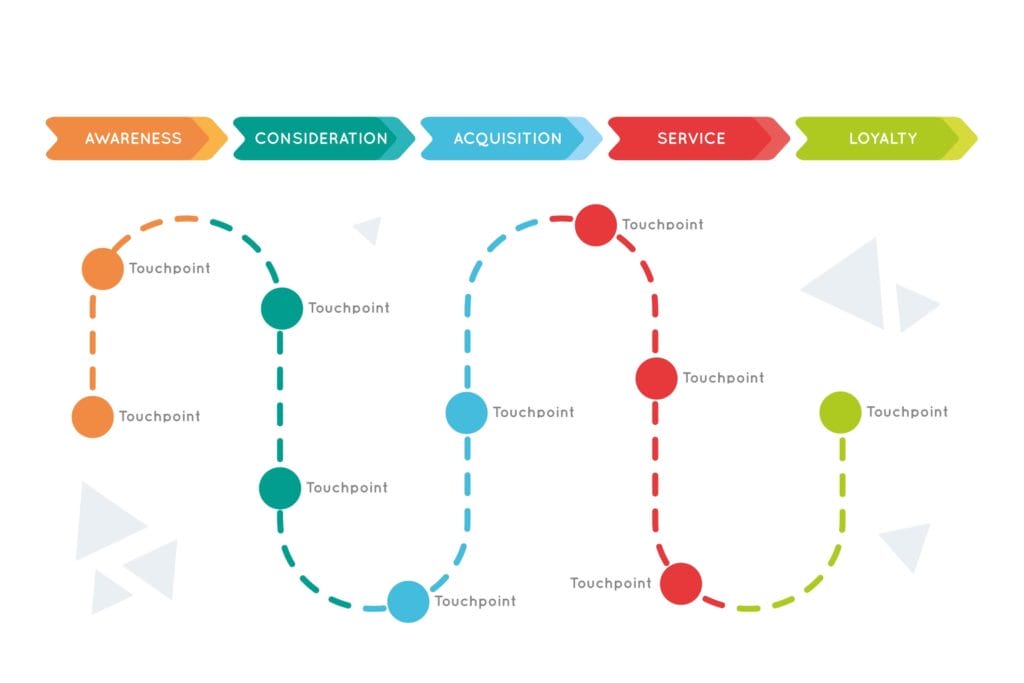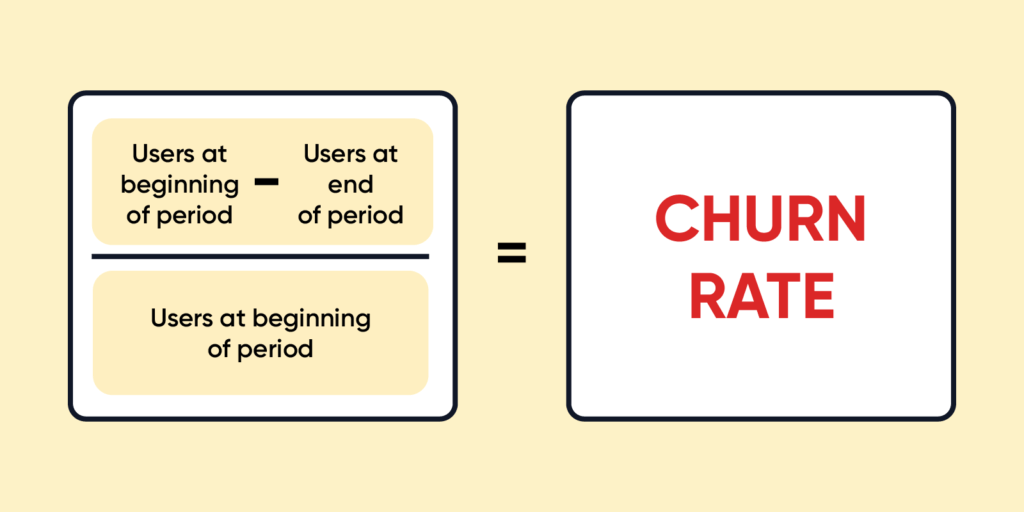Home > Blog > 6 Essential Customer Journey Stages
6 Essential Customer Journey Stages

As a product manager, you never suffer from a lack of things to do. Sometimes when you have so many things you could do, it’s difficult to pick the things you should do. You know you need to focus on outcomes that will help customers solve their problems, and benefit your company as well, but how can you identify those features?
One way to select the right outcomes from a customer-focused perspective is to understand the journey your customers take when interacting with your product. Let’s look at customer journeys and how they can guide the work of your product team.
What is a customer journey?
A customer journey is the story of your customer’s end-to-end relationship with your company, product, or service. It describes the interactions customers have with your company from when they initially find out about your company until they are an active user of the product.
A customer journey map is a graphic or narrative representation of the customer journey. The map can take many forms, including infographics, illustrations, or diagrams.
The customer journey map illustrates all your customers’ interactions with the business over time and across service channels. Based on the customer’s perspective, it shows the meeting points between your customer’s expectations and the requirements of your business.

How to understand the digital customer journey
Your product team should map out your customer’s journey so you can understand your customer experience. You’ll see what it’s like for prospective and existing customers to deal with your products.
The customer journey can help you see the experience of purchasing your product through your customers’ eyes. That perspective helps you structure your buying process to encourage people to purchase your product, and avoid issues that scare people away.
The customer journey can also help you understand your existing customer’s touchpoints with your company to understand how to keep customers and get referrals to new potential customers.
Touchpoints refer to any time a customer comes into contact with your company—before, during, or after they buy your product. Touchpoints include all offline/online interactions through marketing, in person, or over the phone.
The touchpoints in a customer journey map help you to identify places to improve your interaction with customers. Examples of these interactions include your buying process, your onboarding process, and the overall existing customer experience. These efforts will help you build new revenue and keep existing revenue.
6 Essential stages in your customer’s journey
The specific touchpoints in your customer journey will differ from that of other companies. Regardless of what touchpoints you have, you can organize those touchpoints into six stages.
Here’s a look at those six stages and how they can guide your efforts.
1. Awareness
In this stage, a potential customer has a problem they’d like to solve and they are hunting for a solution. The potential customer is not ready to buy at this point. They are just looking for alternatives. People don’t know about your product yet, so you’re trying to get their attention through intent based traffic, content marketing, or paid advertisements.
All of those attraction mechanisms point potential customers to one of these common touchpoints:
- A blog post on your website describing how potential clients can solve their problem (ideally using your product)
- Product how-to’s and tutorials from your website
- White papers or ebooks that explain how people can solve their specific problem.
To know that your efforts at building awareness are working, use metrics such as
- the number of views on key pieces of content
- click-through rates on social media posts or advertisements.
- Brand searches on Google
Experiments you may run during this stage include determining if you’re focusing on the right problem, and whether the content you provide draws in interested potential customers.

2. Consideration
In the consideration stage, a potential customer collects information about your product to see if it will solve their problem. They may look only at your product, or they may compare it to your competitors. Your potential customers are trying to pick the best solutions from all of their options. They’ll compare the features and benefits of various solutions and look to find the solution that’s priced right.
These potential customers want to get a deeper understanding of your product, so they’ll be particularly interested in webinars about your product, demos, or free trials. A good metric to use in this stage is the number of sign-ups for webinars, demos, or free trials. It’s also helpful to keep track of how many people that sign up for webinars and demos attend them and how many people use the free trial.
However, let’s keep in mind that, as product management professionals, we also want to examine usage and product engagement metrics. Therefore, the consideration phase is where we can measure product market fit by examining not only signups to product trials or website visits but actual usage or conversions on our digital products, albeit free ones.
You can experiment with your call to actions for webinars, demos, and free trials to improve these metrics. You can also revise the content of those touch points to drive more action from people who attend webinars and demos or request free trials.
3. Purchase
In the purchase stage, potential customers are approached to purchase a product or subscribe to a service. As a result, your potential customers are now on their final leg. Some customers will drop off while trying to purchase your product if the purchase process is confusing or time-consuming.
As you may expect, the key touchpoints during this stage include your checkout page and process, subscription process, or physical store interactions depending on your product. The best metrics to track for this stage include the number of people who purchase or subscribe in a time period. You may track this daily, weekly, or monthly depending on the number of purchases you get balanced by how long of a feedback cycle you want.
Another metric to pay attention to is the abandonment rate. This rate compares the number of abandoned purchase transactions to the total number of transactions started in the same time frame.
You’ll most likely focus your experiments in this stage on addressing your abandonment rate. According to the Baymard Institute, the average abandonment rate is just about 70%, so you probably won’t ever get your rate anywhere close to zero. But you can take steps to improve your abandonment rate by focusing on addressing some common factors that cause people to abandon the purchase process.
4. Adoption
Once someone purchases your product, you’ll need to get them set up to use your product.
Getting new users set up is the focus of the adoption (also known as activation or onboarding) stage. The extent of onboarding that customers need to do varies by product, but a bad onboarding process can push people away from your product. Common touchpoints during the adoption phase are anything a new customer needs to interact with to use your product. Examples include customer support, support articles, or an onboarding wizard.
To gauge the effectiveness of your onboarding activities, you can track user churn. User churn is the rate of users that stop using your product after the first hours or days after purchasing your product. Addressing user churn can have a large impact on your business. After all, reducing customer churn by 5% can increase profits by 25%.

Your experiments in this area reduce the complexity of your onboarding process and help new users perform key product activities. For example, Slack encourages new users to send their first message or invite their friends.
5. Retention
The focus of the retention stage is to make sure new and existing users continue to use your product. After all, it’s much easier to sell to existing customers (especially if you have a subscription product) than continuously find new customers. The key touchpoints during this stage are all the interactions that users have with the product, customer support, or customer success.
To gauge your product’s performance in this stage in some form, use an active user metric. The active use metric counts the number of users that take some action within your product within a time period. That time period could be daily, weekly, or monthly.
You’ll typically pay attention to the trend of this metric If an active user metric declines, you’d then conduct experiments to determine what’s causing the decline and address it.
6. Advocacy
The final stage of the customer journey is the advocacy or referral stage. In this stage, your customers go beyond buying and using your product to actively advocate that others use it as well. Not every customer will become an advocate, but you should try to get as many here as you can. When more people refer their friends and family to your product, you don’t have to spend as much effort and money trying to attract new customers.
Common touchpoints in this stage can be as simple as social media shares or involved as a referral program. These touchpoints are all ways that existing customers can interact with your product to recommend it to others. A metric you can use to gauge your product’s performance in this stage is to track the referral rate. The referral rate is the ratio of referral purchases compared to the total number of purchases in a time period.
Track the trend in referral rate and run experiments to increase referrals when the trend shows referrals are decreasing. These experiments may include tweaks to a referral program or introducing new features that increase the likelihood of existing customers recommending your product to others.
How to benefit from customer journey maps
Customer journeys provide necessary context around people’s interactions with your product. You can understand how you help potential customers decide to buy your product and you can see how you encourage existing customers to recommend your product to their friends.
Your product team can use a customer journey map to organize the work they do. To do this, monitor the metrics in each stage and pick your experiments to move those metrics in the right direction. craft.io gives you the ability to tie everything together through its Strategic Inputs, Roadmapping, and Spec Editor.
Book a demo today to see how craft.io helps use your customer journey map to build a better customer experience.


